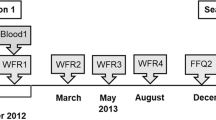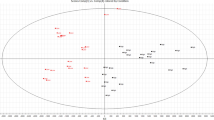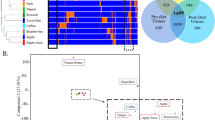Abstract
Objectives: to predict flavonols content of the habitual diets of free-living subjects from urine and plasma concentrations of flavonols.
Design: Ten type 2 diabetic patients (five male, five female), mean age 60 (s.e.m. 7) y and BMI 30.2 (s.e.m. 3.5) kg/m2 were treated in a random crossover design for a 2 week period on either a low flavonoid diet or on the same diet supplemented at one of two high flavonols levels (total 77.3 or 110.4 mg/day) provided by supplements of 1500 ml tea daily and 400 g fried white onion in olive oil with and without tomato ketchup and herbs.
Setting: Glasgow Royal Infirmary, University of Glasgow, Scotland.
Main outcome measures: Fasting plasma concentration, urine concentration and 24 h excretion of quercetin, isorhamnetin, kaempferol and myricetin.
Results: Plasma flavonol concentration (r=0.750, P=0.001), 24 h urine concentration (r=0.847, P=0.001) and 24 h urine excretion (r=0.728, P=<0.001) were all highly significantly related to dietary intake and gave similar estimates of intakes. Fasting plasma flavonols concentrations on habitual diets ranged from 0 to 43.7 ng/ml mean. Regression equations were constricted: total flavonols intake r=0.74, P<0.001 and quercetin intake r=0.744, P<0.001. From these equations, flavonol intakes from habitual diets were estimated at 17–50, mean 35 mg/day. Of this, 91% was from quercetin.
Conclusions: Dietary flavonols are absorbed and appear in plasma and urine as potential biomarkers in concentrations related quantitatively to intake. Estimation of dietary intake from plasma or urine concentrations appears possible.
Sponsorship: Rank Prize Funds and Rank Foundation of the Department of Human Nutrition; Ministry of Health and Medical Education, IR Iran.
European Journal of Clinical Nutrition (2000) 54, 143–149
This is a preview of subscription content, access via your institution
Access options
Subscribe to this journal
Receive 12 print issues and online access
$259.00 per year
only $21.58 per issue
Buy this article
- Purchase on Springer Link
- Instant access to full article PDF
Prices may be subject to local taxes which are calculated during checkout
Similar content being viewed by others
Author information
Authors and Affiliations
Contributions
Guarantor: MEJ Lean.
Contributors: All authors were involved in the design, data collection, analysis and writing of the paper.
Corresponding author
Rights and permissions
About this article
Cite this article
Noroozi, M., Burns, J., Crozier, A. et al. Prediction of dietary flavonol consumption from fasting plasma concentration or urinary excretion. Eur J Clin Nutr 54, 143–149 (2000). https://doi.org/10.1038/sj.ejcn.1600908
Received:
Revised:
Accepted:
Published:
Issue Date:
DOI: https://doi.org/10.1038/sj.ejcn.1600908
Keywords
This article is cited by
-
Oxidative Stress: a Promising Target for Chemoprevention
Current Pharmacology Reports (2016)
-
Comparative inhibitory potential of selected dietary bioactive polyphenols, phytosterols on CYP3A4 and CYP2D6 with fluorometric high-throughput screening
Journal of Food Science and Technology (2015)
-
Determination of quercetin concentrations in fish tissues after feeding quercetin-containing diets
Aquaculture International (2009)
-
Urinary excretion of 13 dietary flavonoids and phenolic acids in free-living healthy subjects – variability and possible use as biomarkers of polyphenol intake
European Journal of Clinical Nutrition (2008)
-
Biomarkers of dietary intake of flavonoids and phenolic acids for studying diet–cancer relationship in humans
European Journal of Nutrition (2008)



